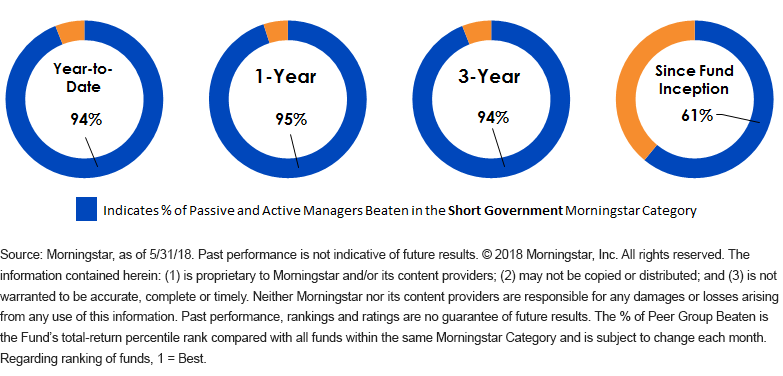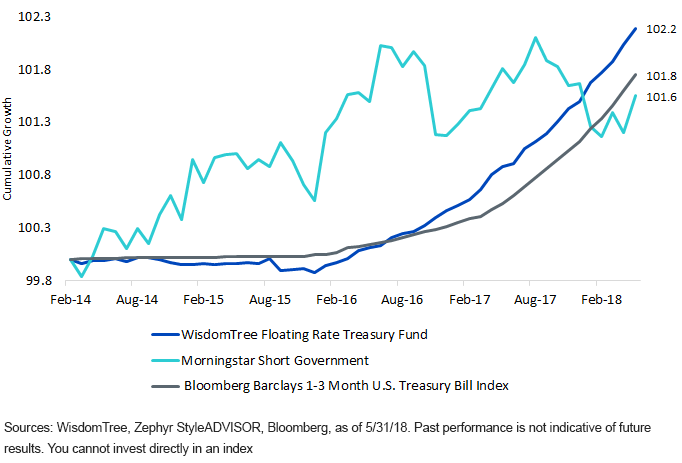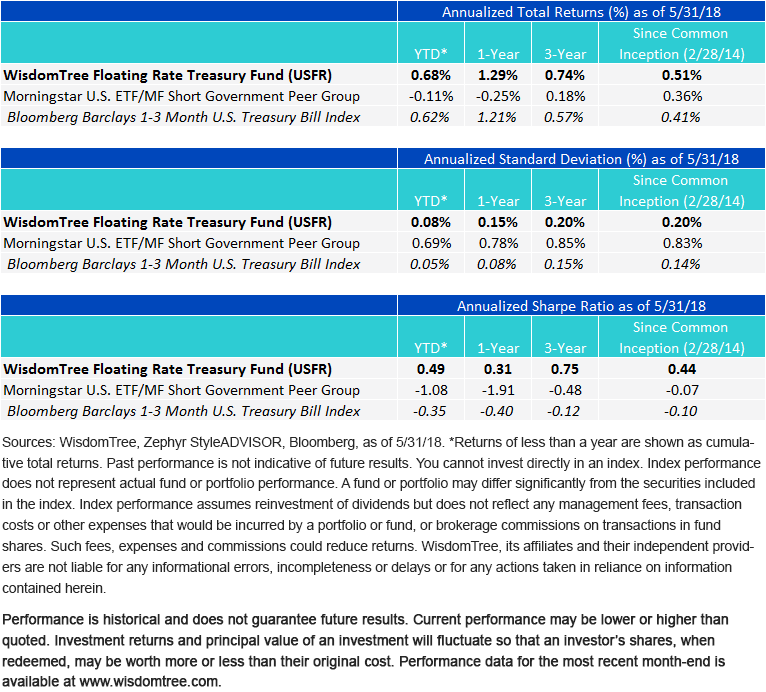Floating to the Top of Morningstar Performance Peer Groups


As expected, the Federal Open Market Committee (FOMC) raised rates for the second time in 2018 during its June meeting, continuing down the path of rate stabilization. Given its transparent indications to have sustained rate hikes for the following quarters and years ahead, investors should consider how they can best protect their portfolios from interest rate risk, if they haven’t already done so. In many instances, investors have sought the protection of short maturity or money market funds. In fact, nearly $11.3 billion has flowed into short Treasury funds year-to-date. While this trade has generally outperformed longer maturity fixed income as rates rose, it’s possible they may be leaving returns on the table. Below, we see how the WisdomTree Floating Rate Treasury Fund (USFR) has compared to both active and passive approaches in short maturity fixed income strategies.
FRNs 101
Floating rate notes (FRNs) were first issued in January 2014. Given that they are issued by the U.S. government, they have great liquidity and virtually no credit risk. Instead of paying a fixed rate of interest like other securities, FRN coupon payments are based on a reference rate to 90-day t-bills, which are auctioned every week.
The benefits of FRNs are twofold. By resetting weekly, FRNs’ effective duration is one week. Given that these securities are assumed to be free of default risk, the value of them is then solely determined by the interest rate at each weekly auction. As 90-day t-bills are among the most sensitive to interest rate changes conducted by the FOMC, this provides an opportunity to boost income as the Fed hikes rates.
WisomTree Floating Rate Treasury Fund
Year-to-date, USFR has seen inflows of over $150 million. This Fund has become a very popular solution for those looking for a cost effective (.15% annual expense ratio) way to access these newly issued FRNs. In fact, on a percentile basis, USFR has been the fastest-growing exchange-traded fund for 2018. When comparing USFR with its Morningstar peer group (the Morningstar Short Government Category), this fairly straightforward approach based on total return has been able to beat more than 94% of active and passive managers over the last three years.
Figure 11: USFR Fund Performance Relative to Morningstar Short Government Peer Group

Since the Fund’s inception on February 4, 2014, the strategy has also outperformed 61% of all managers. As seen in figure 2, during the very early months of USFR’s lifespan, yields were at all-time lows, paying next to nothing. After the Fed began to raise rates in late December 2015, we began to see continued outperformance of the strategy over the Short Government Category and a benchmark of 1- to 3- month t-bills.
Figure 2: USFR Cumulative Fund Performance Relative to Morningstar Peer Group and 1- to 3-Month T-Bills

Finally, while the performance story has shown to be favorable, USFR was able to achieve these superior results with lower volatility. Again, we believe that as long as investors expect more rate hikes from the Fed, it makes sense to allocate short maturity assets in floating rate notes.
Figure 3: Performance, Volatility, and Sharpe of USFR, Morningstar Peer Group & 1- to 3-Month T-Bills

For standardized performance of USFR, please click here.
Please visit our glossary for definitions of terms and indexes in the chart.
In our view, this heavily implies that the debate in the short maturity government category is less of a debate between “active and passive” and more between “fixed versus floating.” While investors have many ways to address interest rate sensitivities, we believe that an allocation to FRNs can provide investors with a unique tool to hedge duration risk and participate in interest rate hikes while mitigating overall risks.
Unless otherwise noted, all data as of May 31, 2018. Sources: WisdomTree, Bloomberg, Morningstar, Zephyr StyleADVISOR
1Total number of Short Government managers: Year-to-Date = 107; 1-Year = 105; 3-Year = 102; Since Fund Inception (3/1/14) = 99.
Important Risks Related to this Article
There are risks associated with investing, including possible loss of principal. Securities with floating rates can be less sensitive to interest rate changes than securities with fixed interest rates but may decline in value. The issuance of floating rate notes by the U.S. Treasury is new and the amount of supply will be limited. Fixed income securities will normally decline in value as interest rates rise. The value of an investment in the Fund may change quickly and without warning in response to issuer or counterparty defaults and changes in the credit ratings of the Fund’s portfolio investments. Due to the investment strategy of this Fund, it may make higher capital gain distributions than other ETFs. Please read the Fund’s prospectus for specific details regarding the Fund’s risk profile.


